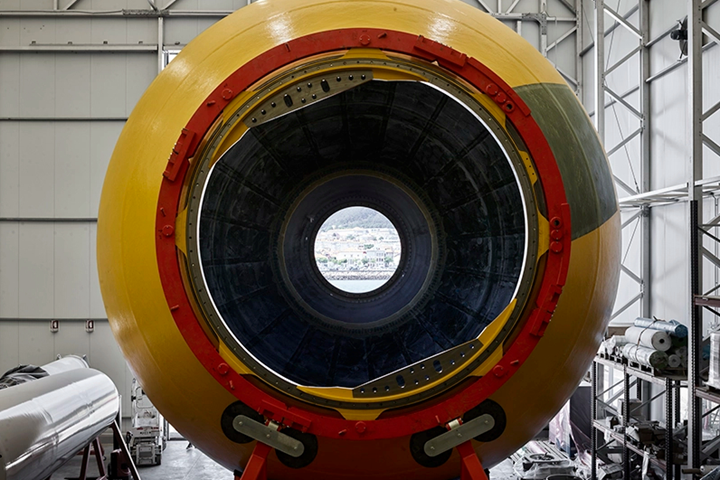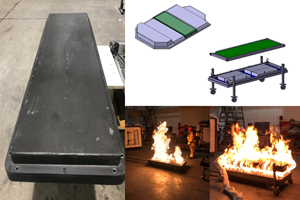CorPower Ocean delivers first commercial-scale composite WEC hull
Custom-built, environmentally controled workcell forms integral part of composite hull construction, will lead to future manufacturing scaleup and mobility.

Photo Credit: CorPower Ocean
CorPower Ocean (Stockholm, Sweden) has teamed up with composite machinery specialist Autonational BV (Iljst, Netherlands) and composite tank experts CPT Tankwell (Wieringerwerf, Netherlands) to successfully develop its first commercial-scale composite wave energy converter (WEC) hull in Viana do Castelo (Portugal). The hull is to be developed using a custom-built machine, installed inside an environmentally controlled workcell that will become the future regarding mobility and scalability of CorPower’s composites manufacturing capabilities.
The composite hull forms an integral part of CorPower Ocean’s next-generation C4 WEC which was recently unveiled at a global launch event in Stockholm.
Over the last year, process characterization work on quarter-scale models has enabled rapid iterations and continuous tuning to reach targeted quality and material properties reviewed by DNV (Høvik, Norway) as a certification body — paving the way for final commercial-scale construction, according to CorePower Ocean. Completed at the company’s Portuguese base in Viana do Castelo, it marks an important milestone in the flagship HiWave-5 Project, which will involve ocean deployment in nearby Aguçadoura.
Read more, “Industrial-scale wave energy system enabled by mobile filament winding.”
“This has been a tremendous team effort involving our specialist composite team in Portugal and Sweden with close cooperation with our local and global supply chain partners,” Miguel Silva, managing director for CorPower Ocean Portugal, says. “The C4 hull has been designed with a low-cost sandwich structure comprising filament-wound composite skins for the inner and outer layer separated by a core material. This approach brings a raft of benefits including high strength, durability and impact resistance combined with light weight and buoyancy performance properties, which can withstand fatigue, slamming and impact loads. Other important features include excellent adhesion strength and chemical resistance with low water absorption.”
The hull construction has been carried out in conjunction with dry-testing of CorPower Ocean’s power take off (PTO) system, using what the company says is the world’s largest wave energy test rig. In its entirety, the composite hull development workcell consists of a fully customized filament winding machine situated on a 14-meter-long base. This includes an automated carrying system to apply fibers onto a 9-meter diameter mandrel, to wind the hull layer by layer.
“Based on the R&D cell in Viana do Castelo, future versions of such manufacturing cells can be easily integrated in port or final assembly facilities, amounting to ‘mobile factories,’” Tord Jonsson, Supply chain and quality manager, says. “This will enable composite hulls to be built rapidly on customer sites, with additive manufacturing dramatically reducing lead times, cost and carbon footprint by eliminating transportation of the finished product. Delivering wave farms to our customers, we will be moving these factory cells from site the site, to produce the hulls needed for a project, then move the cells over to the next customer site. The equipment will be packed and transported in three standard containers, taking only a few days to assemble once delivered to a new site. Our ‘mobile factory’ concept enables high local content in projects, and will play a key role in revitalizing local port communities and local supply chains.”
Working in collaboration with several utility companies, CorPower Ocean’s first commercial-scale C4 WEC will be used to form part of a larger four-system array, and a wave farm generating energy to the national grid. CorPower Ocean’s CEO, Patrik Möller says the overall mission is to successfully introduce certified and warrantied WEC products to the market, making wave energy a bankable technology to attract mainstream renewable project finance and drive rapid deployment scaleup to address climate change.
Related Content
Materials & Processes: Fabrication methods
There are numerous methods for fabricating composite components. Selection of a method for a particular part, therefore, will depend on the materials, the part design and end-use or application. Here's a guide to selection.
Read MorePEEK vs. PEKK vs. PAEK and continuous compression molding
Suppliers of thermoplastics and carbon fiber chime in regarding PEEK vs. PEKK, and now PAEK, as well as in-situ consolidation — the supply chain for thermoplastic tape composites continues to evolve.
Read MoreA new era for ceramic matrix composites
CMC is expanding, with new fiber production in Europe, faster processes and higher temperature materials enabling applications for industry, hypersonics and New Space.
Read MorePrice, performance, protection: EV battery enclosures, Part 1
Composite technologies are growing in use as suppliers continue efforts to meet more demanding requirements for EV battery enclosures.
Read MoreRead Next
From the CW Archives: The tale of the thermoplastic cryotank
In 2006, guest columnist Bob Hartunian related the story of his efforts two decades prior, while at McDonnell Douglas, to develop a thermoplastic composite crytank for hydrogen storage. He learned a lot of lessons.
Read MoreComposites end markets: Energy (2024)
Composites are used widely in oil/gas, wind and other renewable energy applications. Despite market challenges, growth potential and innovation for composites continue.
Read MoreCW’s 2024 Top Shops survey offers new approach to benchmarking
Respondents that complete the survey by April 30, 2024, have the chance to be recognized as an honoree.
Read More

























